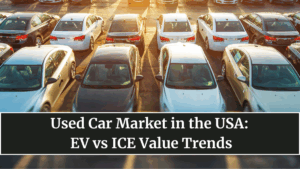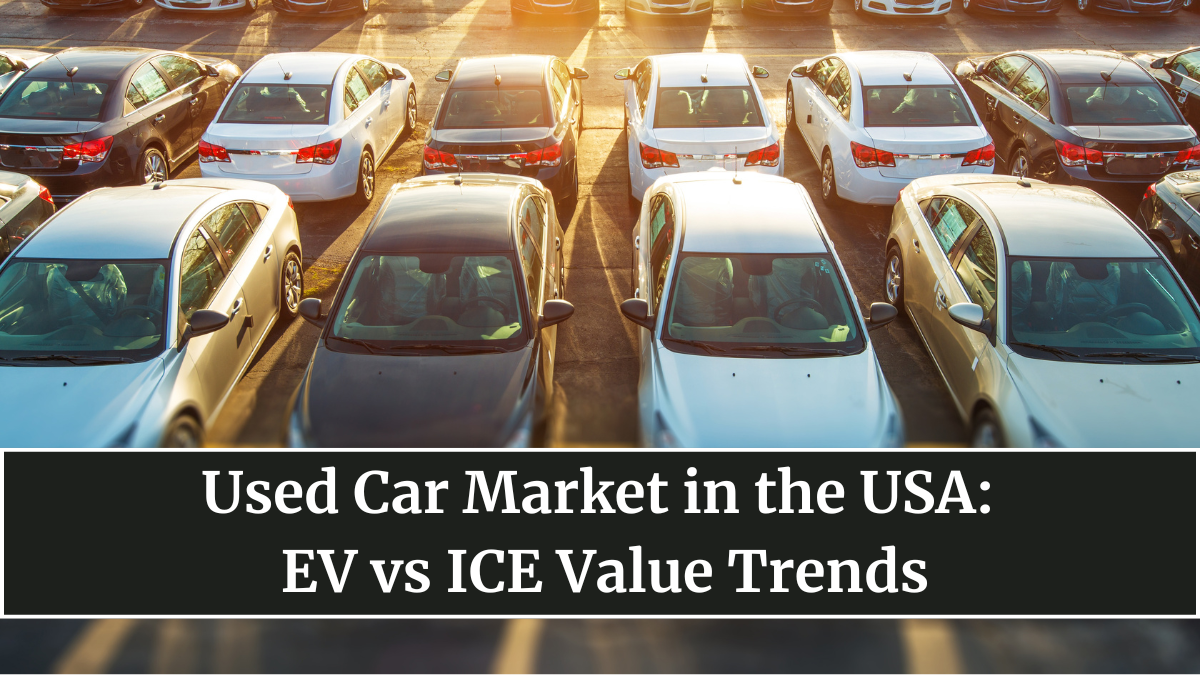The American used-car market is entering a transformative phase, driven by the growing competition between electric vehicles (EVs) and internal combustion engine (ICE) cars. What was once a clear market dominated by gas-powered vehicles is now a complex ecosystem where EVs are beginning to make their mark — yet facing unique value-retention challenges.
As more electric cars enter the second-hand market, questions around battery life, depreciation, and consumer perception are shaping new resale dynamics in the auto industry.

The Shift in America’s Used Car Landscape
The U.S. used-car market, valued at over $1.2 trillion in 2024, has traditionally been dominated by ICE vehicles. However, the rapid growth in EV sales — over 1.4 million new EVs sold in 2024 — is bringing a steady wave of electric models into the resale segment.
Key factors influencing this shift include:
-
Rising EV adoption: More trade-ins as first-generation EV buyers upgrade to newer models.
-
Inflation and affordability: Used vehicles remain the top choice for cost-conscious buyers.
-
Federal incentives: Tax credits for pre-owned EVs have boosted buyer confidence.
-
Environmental awareness: More consumers prefer sustainable vehicle ownership.
Still, while EV sales are growing fast, resale dynamics differ sharply from ICE vehicles — largely because of battery degradation rates and market maturity.
EV Depreciation vs ICE Depreciation: The Real Numbers
Depreciation remains the single biggest challenge for EVs in the used market. On average, EVs lose value faster than gasoline cars, especially within the first three years.
| Vehicle Type | Average 3-Year Depreciation | Key Reason |
|---|---|---|
| Electric Vehicle (EV) | 48–52% | Rapid tech upgrades and battery performance uncertainty |
| Hybrid Vehicle | 42–45% | Balanced demand due to fuel efficiency and low emissions |
| ICE Vehicle (Gas/Diesel) | 38–41% | Mature resale market and stable maintenance costs |
However, this gap is narrowing rapidly as battery technology improves and public trust grows. EVs from brands like Tesla, Rivian, and Hyundai retain significantly higher resale values than earlier electric models.
Factors Driving EV Resale Value Improvement
The modern used-EV market is maturing, thanks to innovation, policy, and consumer behavior:
-
Battery warranties: Extended manufacturer warranties (8 years or 160,000 km) build confidence among buyers.
-
Charging infrastructure: Expanding fast-charging networks across the U.S. reduce range anxiety.
-
Government incentives: Used-EV buyers can claim up to $4,000 in federal tax credits.
-
Software updates: OTA upgrades improve vehicle performance and resale appeal.
-
Brand perception: EV-focused automakers are now seen as premium tech brands, not niche startups.
These trends are helping normalize EV ownership in the secondary market, where resale demand is projected to grow 20% annually through 2026.
Challenges Facing Used EVs in the U.S.
Despite progress, the used EV market faces some ongoing hurdles:
-
Battery health transparency: Limited standardized tools for measuring battery degradation.
-
Rapid technology turnover: Frequent model upgrades make older EVs feel outdated.
-
Limited financing options: Banks remain cautious about long-term EV loan approvals.
-
Repair expertise: Many local workshops lack EV servicing infrastructure.
-
Market education: Buyers still perceive used EVs as risky or short-lived investments.
To overcome these barriers, several automakers have introduced certified pre-owned (CPO) programs for EVs — offering full inspections, battery guarantees, and reconditioning.
The ICE Market Still Holds Ground
Internal combustion vehicles continue to dominate resale volumes due to lower initial costs, abundant inventory, and familiarity. However, ICE cars are beginning to lose long-term resale advantage as stricter emission standards and city-level restrictions push buyers toward cleaner options.
Used hybrid and plug-in hybrid models are also attracting strong demand, acting as a bridge between ICE reliability and EV sustainability.
The Road Ahead: EV Resale Market by 2030
By the end of this decade, EVs could make up 25–30% of all used vehicle sales in the U.S., supported by longer battery lifespans, standardized diagnostic systems, and growing public confidence.
Future growth will be shaped by:
-
AI-powered resale valuation tools that account for battery health.
-
Expansion of EV-only used car marketplaces.
-
Battery replacement services lowering maintenance anxiety.
-
Growing rural charging networks for used EV buyers outside urban centers.
The U.S. used car market is evolving from an engine-based economy to an energy-based economy, where data, charging, and sustainability drive value — not just horsepower.
The competition between EVs and ICE cars isn’t about who wins today, but who adapts faster to tomorrow’s realities.
FAQs
Do electric cars lose value faster than petrol cars?
Yes, early-generation EVs depreciated faster, but newer models retain value better due to stronger demand and longer battery warranties.
Are used EVs worth buying in 2025?
Absolutely. With improved infrastructure, warranties, and incentives, buying a used EV is more practical and affordable than ever.
Which EV brands have the best resale value?
Tesla, Rivian, and Hyundai currently lead in resale value retention in the U.S. market.
Can I get tax credits for buying a used EV?
Yes, qualifying used EVs are eligible for a $4,000 federal tax credit under updated U.S. clean vehicle programs.
What’s the future of used EV vs ICE resale values?
By 2030, EV resale values are expected to align closely with ICE vehicles, thanks to battery innovations and consumer confidence growth.
Click here to know more.
